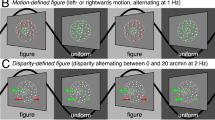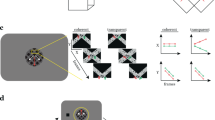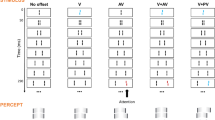Abstract
The visual system analyses information by decomposing complex objects into simple components (visual features) that are widely distributed across the cortex1,2. When several objects are present simultaneously in the visual field, a mechanism is required to group (bind) together visual features that belong to each object and to separate (segment) them from features of other objects. An attractive scheme for binding visual features into a coherent percept consists of synchronizing the activity of their neural representations3,4,5,6. If synchrony is important in binding, one would expect that binding and segmentation are facilitated by visual displays that are temporally manipulated to induce stimulus-dependent synchrony. Here we show that visual grouping is indeed facilitated when elements of one percept are presented at the same time as each other and are temporally separated (on a scale below the integration time of the visual system7) from elements of another percept or from background elements. Our results indicate that binding is due to a global mechanism of grouping caused by synchronous neural activation, and not to a local mechanism of motion computation.
This is a preview of subscription content, access via your institution
Access options
Subscribe to this journal
Receive 51 print issues and online access
$199.00 per year
only $3.90 per issue
Buy this article
- Purchase on Springer Link
- Instant access to full article PDF
Prices may be subject to local taxes which are calculated during checkout


Similar content being viewed by others
References
Van Essen, D. C. Cerebral Cortex (eds Peters, A. & Jones, E. G.) 259–329 (Plenum, New York, (1985)).
Tanaka, K. & Saito, Y. Coding of visual images of objects in the inferotemporal cortex of macaque monkey. J. Neurophysiol. 66, 170–189 (1991).
Milner, P. Amodel for visual shape recognition. Psychol. Rev. 81, 521–535 (1974).
von der Malsburg, C. in Models of Neural Networks II (eds Domany, E., van Hemmen, J. L. & Shulten, K.) 95–119 (Springer, Berlin, (1981)).
Crick, F. & Koch, C. Towards a neurobiological theory of consciousness. Semin. Neurosci. 2, 263–275 (1990).
von der Malsburg, C. Binding in models of perception and brain function. Curr. Opin. Neurobiology 5, 520–526 (1995).
Colheart, M. Iconic memory and visible persistence. Percept. Psychophys. 27, 183–228 (1980).
Singer, W. & Gray, C. M. Visual feature integration and the temporal correlation hypothesis. Annu. Rev. Neurosci. 55, 349–374 (1995).
Singer, W., Engel, A. K., Kreiter, A. K. & Munk, M. H. J. Neuronal assemblies: necessity, significance and detectability. Trends Cogn. Sci. 1, 252–261 (1997).
Keele, S. W., Cohen, A., Ivry, R., Liotti, M. & Lee, P. Tests of a temporal theory of attentional binding. J. Exp. Psych. Hum. Percept. Perform. 14, 444–452 (1988).
Kiper, D. S., Gegenfurtner, K. R. & Movshon, A. Cortical oscillatory responses do not affect visual segmentation. Vision Res. 36, 539–544 (1996).
Fahle, M. & Koch, C. Spatial displacement, but not temporal asynchrony, destroys figural binding. Vision Res. 35, 491–494 (1995).
Fahle, M. Figure ground discrimination for temporal information. Proc. R. Soc. Lond. B 254, 199–203 (1993).
Leonards, U., Singer, W. & Fahle, M. The influence of temporal phase differences on texture segmentation. Vision Res. 36, 2689–2697 (1996).
Leonards, U. & Singer, W. Two segmentation mechanisms with differential sensitivity for colour and luminance contrast. Vision Res. 38, 101–109 (1998).
Beck, J. in Organization and Representation in Perception (ed. Beck, J.) 285–317 (Erlbaum, Hillsdale, NY, (1982)).
Gregory, R. L. Eye and Brain: The Psychology of Seeing3rd edn (Weidenfeld and Nicolson, London, (1997)).
Barchilon Ben-Av, M. & Sagi, D. Perceptual grouping by similarity and proximity: experimental results can be predicted by intensity autocorrelations. Vision Res. 35, 853–866 (1995).
Oyama, T. & Yamada, W. Perceptual grouping between successively presented stimuli and its relation to visual simultaneity and masking. Psychol. Res. 40, 101–112 (1978).
Tso, D. Y., Gilbert, C. & Wiesel, T. N. Relationships between horizontal interactions and functional architecture in cat striate cortex as revealed by cross-correlation analysis. J. Neurosci. 3, 1160–1170 (1986).
Lund, J. S., Takashi, Y. & Levitt, J. B. Comparison of intrinsic connectivity in different cortex of the cerebral cortex. Cerebral Cortex 3, 148–162 (1993).
Ball, K., Sekuler, R. & Machamer, J. Detection and identification of moving targets. Vision Res. 23, 229–238 (1983).
Field, D. J., Hayes, A. & Hess, R. F. Contour integration by the human visual system: evidence for a local “association field”. Vision Res. 33, 173–193 (1993).
Roelfsema, P. R., Konig, P., Engel, A. K., Sireteanu, R. & Singer, W. Reduced synchronisation in the visual cortex of cats with strabismic amblyopia. Eur. J. Neurosci. 6, 1645–1655 (1994).
Loftus, G. R., Busey, T. A. & Senders, J. W. Providing a sensory basis for models of visual information acquisition. Percept. Psychophys. 54, 535–554 (1993).
Acknowledgements
We thank Y. Bonneh, E. Niebur and D. Sagi for discussions; N. Blue and A. Found for software assistance; and D. Vernon and Z. James for help in running experiments.
Author information
Authors and Affiliations
Corresponding author
Rights and permissions
About this article
Cite this article
Usher, M., Donnelly, N. Visual synchrony affects binding and segmentation in perception. Nature 394, 179–182 (1998). https://doi.org/10.1038/28166
Received:
Accepted:
Published:
Issue Date:
DOI: https://doi.org/10.1038/28166
This article is cited by
-
A Measure of Concurrent Neural Firing Activity Based on Mutual Information
Neuroinformatics (2021)
-
The structure of audio–visual consciousness
Synthese (2021)
-
Temporal asynchrony and spatial perception
Scientific Reports (2016)
-
STDP in lateral connections creates category-based perceptual cycles for invariance learning with multiple stimuli
Biological Cybernetics (2015)
-
A review of cell assemblies
Biological Cybernetics (2013)
Comments
By submitting a comment you agree to abide by our Terms and Community Guidelines. If you find something abusive or that does not comply with our terms or guidelines please flag it as inappropriate.



